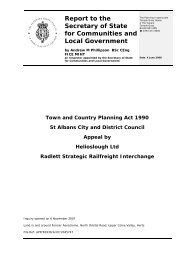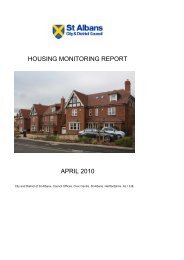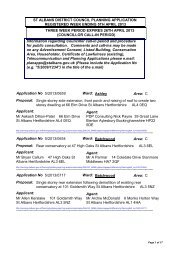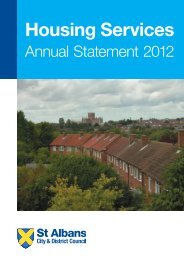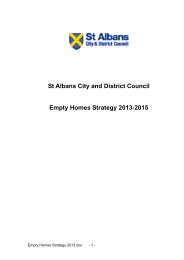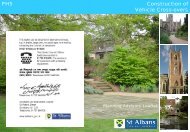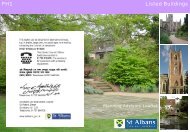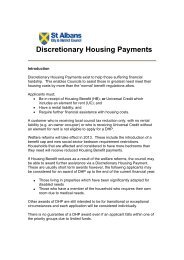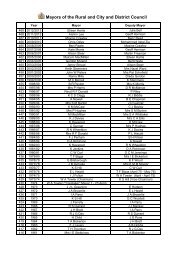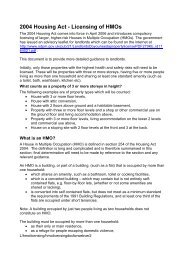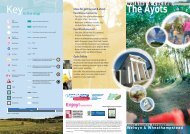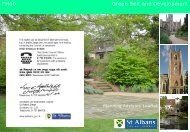Going smoke-free - St Albans City & District Council
Going smoke-free - St Albans City & District Council
Going smoke-free - St Albans City & District Council
Create successful ePaper yourself
Turn your PDF publications into a flip-book with our unique Google optimized e-Paper software.
PH28<br />
<strong>Going</strong> Smoke-<strong>free</strong>:<br />
A Planning Guide to Smoking Shelters<br />
Planning Advisory Leaflet
GOING SMOKE-FREE: A PLANNING GUIDE TO<br />
SMOKING SHELTERS<br />
Introduction<br />
Smoke-<strong>free</strong> legislation in the Health Act 2006 came into force in<br />
England on 1 July 2007. The aim of the legislation is to create<br />
<strong>smoke</strong>-<strong>free</strong> places in order to protect workers and the general<br />
public from the harmful effects of passive or secondary smoking.<br />
The Act introduces a statutory smoking ban in what are defined as<br />
‘enclosed’ or ‘substantially enclosed’ premises.<br />
The new law will affect most public premises, including restaurants,<br />
pubs, bars, shops, cinemas, shopping centres, leisure centres,<br />
offices, factories and other enclosed or substantially enclosed<br />
workplaces, and public transport.<br />
There are some exemptions, which include:<br />
private accommodation but not common parts, for example<br />
staircases and lifts;<br />
hotel accommodation;<br />
other residential accommodation in care homes, hospices,<br />
mental health units;<br />
adult prisons.<br />
Evidence from Ireland and Scotland, where bans have been in<br />
existence since March 2004 and March 2006 respectively, indicates<br />
that many licensed premises will seek to provide areas for <strong>smoke</strong>rs,<br />
by providing facilities such as smoking shelters, canopies or other<br />
covered outside areas, which, when combined with the use of<br />
outdoor space heaters, enables them to be used in most weathers.<br />
These structures have some form of roof and a combination of walls<br />
and openings to comply with the provisions of the Health Act.<br />
This planning advisory leaflet is intended to provide planning<br />
guidance on the provision of facilities for <strong>smoke</strong>rs in order to comply<br />
with the new health legislation. However, please note that this<br />
guidance is not a definitive interpretation of the law. It has been<br />
produced to offer advice and assistance on the need for planning<br />
1<br />
permission and the factors that will be taken into account in<br />
deciding whether or not such permission will be granted.<br />
What are ‘enclosed’ and ‘substantially enclosed’<br />
premises?<br />
Whether a proposed smoking shelter or related structure complies<br />
with the relevant health legislation is not a planning judgement. This<br />
is a matter for the <strong>Council</strong> as the Environmental Health Authority,<br />
which will be responsible for enforcing the legislation. However, it is<br />
necessary to understand fully the meaning of these two terms in the<br />
new health legislation.<br />
‘Enclosed’ premises have a ceiling or roof and, except for<br />
doors, windows and passageways, are wholly enclosed, either<br />
permanently or temporarily.<br />
‘Substantially enclosed’ premises have a ceiling or roof, but<br />
any openings in the walls have a total area that is less than<br />
half of the area of the walls, including other structures that<br />
serve the purpose of walls and constitute the perimeter of the<br />
premises.<br />
When determining the area of an opening, no account should be<br />
taken of openings where doors, windows or other fittings can be<br />
opened or shut.<br />
A roof includes any fixed or moveable structure or device that is<br />
capable of covering all or part of the premises, and includes, for<br />
example, a retractable canvas awning.<br />
In summary, a smoking shelter with a roof and walls where the<br />
permanent openings have a total area that is the same or less<br />
than the total area of walls will be classified as ‘substantially<br />
enclosed’ and will not fall within the provisions of the health<br />
legislation as a smoking shelter.<br />
Please note: you must ensure that your proposed shelter is not<br />
‘substantially enclosed’. If it is, then it clearly would not comply<br />
with the <strong>smoke</strong>-<strong>free</strong> regulations and you will be wasting your time<br />
and money.<br />
You should also be aware that siting a smoking shelter too close to<br />
the walls of adjacent buildings or fences could have the effect of<br />
2
enclosing the structure to the point where it would become<br />
‘substantially enclosed’.<br />
You are therefore urged to take independent advice from your own<br />
legal adviser before submitting any planning application for a<br />
smoking shelter.<br />
Environmental Health advice should always be sought on planning<br />
applications for smoking shelters and related features.<br />
When is planning permission required?<br />
Planning permission will normally be required for the following<br />
operations and uses:<br />
permanent external smoking shelter structures, whether <strong>free</strong>standing<br />
or attached to existing buildings;<br />
awnings, canopies or blinds attached to buildings, as these will<br />
almost always have a material effect on the external<br />
appearance of a building;<br />
pavement and forecourt tables and chairs sited on the public<br />
highway or a private forecourt;<br />
the use of any land as a beer garden or yard, where the land<br />
does not form part of the business premises;<br />
construction of timber decking;<br />
stub-out bins on the front of premises.<br />
Planning permission will normally not be required for the following<br />
operations and uses:<br />
portable <strong>free</strong>-standing awnings or canopies and space<br />
heaters;<br />
the use of beer gardens and yards where these are ancillary to<br />
the main pub or restaurant use and are lawfully part of the<br />
existing business.<br />
Where there is any doubt about the need for planning permission,<br />
you should check with the <strong>Council</strong>’s Planning Department before<br />
proceeding. However, the <strong>Council</strong> is only able to offer informal<br />
advice without receiving an application. Should you wish to have<br />
formal confirmation that a structure or use does not require planning<br />
permission, you may apply for a Lawful Development (proposed)<br />
Certificate.<br />
3<br />
Application forms for either a Lawful Development Certificate or for<br />
planning permission, can be downloaded from the <strong>Council</strong>’s<br />
website, or obtained from the Customer Service Centre at the<br />
<strong>Council</strong> offices. A fee is payable for both, details of which are<br />
available from the website.<br />
Detailed guidance on the submission of applications is available<br />
from the Planning Department (01727 819344 or 819345) and on<br />
the <strong>Council</strong>’s website (www.stalbans.gov.uk). Applications for<br />
smoking shelters should include calculations to demonstrate that<br />
the structure would not be ‘substantially enclosed’.<br />
Planning applications for smoking shelters and related structures<br />
will normally take up to eight weeks from receipt of a valid<br />
application. Should the application go to a Planning Committee, it<br />
may take longer for a decision to be made.<br />
Material considerations for planning applications<br />
All planning decisions are based upon planning policies contained<br />
within the <strong>Council</strong>’s adopted development plan, related guidance<br />
and any other material considerations.<br />
When assessing a planning application for a shelter, awning or<br />
similar structure, the <strong>Council</strong> will seek to ensure that the facilities<br />
are well designed and sensitively sited in a way that:<br />
enhances the street scene;<br />
<br />
<br />
protects the safety and <strong>free</strong> flow of pavement users;<br />
has no detrimental impact on the amenity of neighbouring<br />
residents.<br />
In particular, the following points will be considered:<br />
Is the shelter, awning or other structure in a prominent<br />
location?<br />
Is the structure well designed, using appropriate materials, and<br />
in character with the existing building?<br />
Will the location or siting of the shelter or awning have any<br />
adverse amenity impact in terms of:<br />
– visual intrusion;<br />
– character and appearance of the area;<br />
– loss of outlook;<br />
4
– overlooking of adjacent residential premises;<br />
– light pollution;<br />
– siting adjacent to doors, windows or air intake systems<br />
(whether within or adjacent to the premises);<br />
– secondary <strong>smoke</strong> infiltration into adjacent residential or<br />
commercial premises<br />
– introduction or intensification of activity and disturbance near<br />
noise-sensitive premises, particularly in the late evening?<br />
Will the siting of the shelter or awning result in loss of parking<br />
spaces, with the associated impact on parking problems in the<br />
vicinity?<br />
Will the shelter or awning obstruct or block an adjacent public<br />
footpath or road to the detriment of pedestrian or traffic safety?<br />
In general, canopies, shelters, heaters and similar structures sited<br />
on the public highway or on other public spaces are unlikely to be<br />
permitted.<br />
Proposals affecting premises in a conservation area, or affecting a<br />
listed building, will be particularly sensitive. The design of any<br />
smoking-related structure or shelter would need to be of exceptional<br />
quality if it is not to affect the character or setting of a listed building,<br />
or the character or appearance of a conservation area.<br />
If planning permission is granted, conditions may be imposed to<br />
restrict, for example, the transmission of music or any other<br />
amplified sound to any noise-sensitive boundary, or hours of<br />
operation (although these are more likely to be addressed under<br />
licensing provisions). In some cases, temporary permission may be<br />
granted to allow the review of any impact in sensitive locations.<br />
Advertisement Consent<br />
If you propose to provide new external signs, for example to direct<br />
customers to smoking shelters, you may need to make a separate<br />
application for Advertisement Consent. Application forms and<br />
guidance can be downloaded from the <strong>Council</strong>’s website<br />
(www.stalbans.gov.uk).<br />
The main concerns in deciding whether to grant consent will be:<br />
highway safety – for example, would the sign cause<br />
obstruction to pedestrians or traffic?<br />
5<br />
<br />
amenity – would the sign be visually obtrusive (particularly in a<br />
conservation area, or on a listed building) or add to<br />
advertisement clutter?<br />
Further information<br />
This advisory leaflet is intended to be a helpful and useful source of<br />
information and not binding on any party. The <strong>Council</strong> offers no<br />
guarantee or warranties concerning the accuracy of the information<br />
supplied.<br />
For more information about the contents of this leaflet contact:<br />
The Planning Department<br />
<strong>St</strong> <strong>Albans</strong> <strong>City</strong> and <strong>District</strong> <strong>Council</strong><br />
<strong>St</strong> Peter’s <strong>St</strong>reet<br />
<strong>St</strong> <strong>Albans</strong>, Hertfordshire AL1 3JE<br />
Telephone: 01727 819344 or 819345<br />
Website: www.stalbans.gov.uk<br />
Produced by <strong>St</strong> <strong>Albans</strong> <strong>City</strong> and <strong>District</strong> <strong>Council</strong><br />
Issued July 2007. PH28(a)<br />
6



